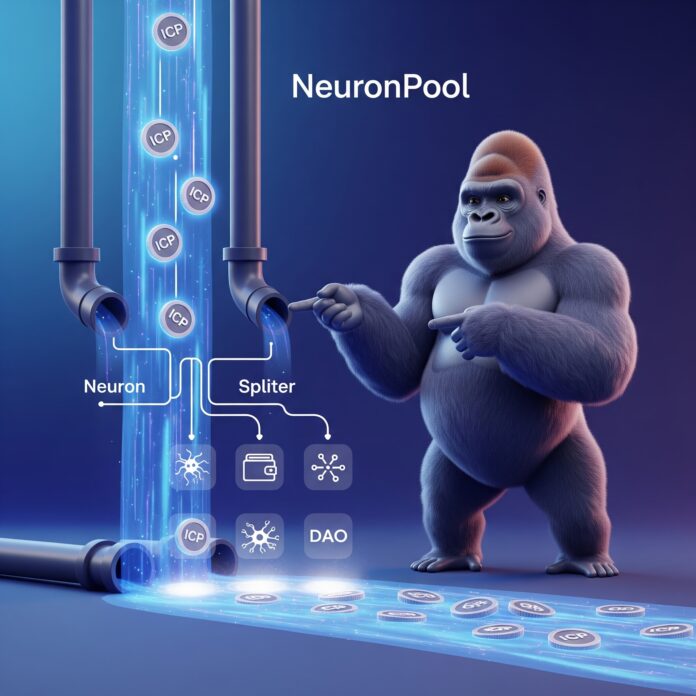KongSwap has rolled onto NeuronPool, bringing with it two much-anticipated tools—Neuron and Splitter vectors. These additions are designed to make maturity management a lot less manual and a touch more tactical. For Internet Computer users who’ve long been waiting to streamline how their neuron rewards flow, Kong’s latest move hits at just the right time.
The idea is straightforward: instead of waiting around to manually handle maturity rewards, users can now direct them to a specific destination automatically. With Neuron vectors, you can route those rewards into another neuron. With Splitter vectors, you can spread them across multiple targets, potentially splitting between staking, liquidation, or further delegation.
This is where the Kong character, both playful and efficient, becomes more than just branding. KongSwap’s rise within the ICP ecosystem has leaned into both community-building and function-first design. It’s now doubling down on decentralised finance tools that don’t just sit on paper but actually solve daily pain points for users navigating governance and staking.
NeuronPool already allowed Internet Computer users to compound maturity or send it to new neurons. The introduction of vectors means you can now assign logic to your flow. Want a portion to be staked and another sent to a wallet? Or maybe set up a system where all rewards are redirected to a single team-managed neuron? These setups are now possible without needing constant manual intervention.
The move has a few practical implications. For users who operate multiple neurons, there’s less clicking and more configuring. DAOs or group-managed neurons can now script out their strategy once and let it run. And individuals who want their maturity to fund something specific—say, another project or their own liquid ICP balance—can now arrange that without babysitting the interface every few days.
KongSwap’s use of the Neuron and Splitter labels might sound light-hearted, but the logic behind them is precise. Neuron vectors focus on sending rewards from one neuron to another—handy for compounding or centralising governance strength. Splitter vectors, on the other hand, allow division—perfect for spreading influence or earnings in multiple directions.
For developers, there’s an API behind it. For regular users, there’s a user interface that aims to be smooth and intuitive. KongSwap has always taken a community-first approach to feature release, and this update feels aligned with that rhythm. Rather than flood the system with complexity, it adds small, purposeful steps that can be adopted gradually.
It’s also about timing. As more ICP holders get involved in governance or experiment with decentralised treasury strategies, tools that allow flexible, programmable maturity handling will likely become more standard than niche. The goal isn’t to over-automate, but to let users shape their own flow patterns and remove friction.
There’s also a strong undercurrent of trust-building. Letting a third-party interface handle sensitive tasks like reward routing requires confidence—not just in the code but in the long-term commitment of the developer team. KongSwap, through consistent small updates and clear documentation, appears to be working toward that trust in manageable steps.
The cartoon monkey may suggest play, but what’s under the surface is tooling for serious, long-term users of the Internet Computer. With neuron staking becoming a longer-term game and decentralised governance maturing by the week, these automation layers don’t come across as luxury—they feel necessary.
Some users are already experimenting with setup combinations—routing a percentage to one neuron, another slice to a liquid wallet, and the rest to a partner DAO. The early feedback? Less maintenance, more predictability.
The Internet Computer ecosystem has long been structured to give users choice—be it in identity, governance, or development. Tools like these support that direction by offering not just choice but convenience. And in a space that’s often too technical for casual users, streamlining something like reward routing might end up being a surprisingly effective on-ramp.
While Neuron and Splitter vectors may seem like simple feature tags, they represent a broader design intention: letting users take control without needing to constantly be on call. It’s that subtle line between automation and autonomy.
Of course, as with any new release, this is just the start. There’s already chatter about future features—condition-based triggers, smart routing based on ICP price, or even collaborative neuron strategies. But even without those yet, KongSwap’s current rollout lays a clean foundation.
This release doesn’t arrive with a splashy token airdrop or speculative gamble. Instead, it focuses on a quieter win: making ICP governance a bit more accessible, a bit more efficient, and a bit more friendly. And sometimes, that’s the kind of progress that sticks.
KongSwap continues to push where it matters—lowering barriers, increasing utility, and giving users just a little more control. The Neuron and Splitter vector update isn’t loud, but it’s deliberate. For those managing maturity rewards, the Internet Computer just got easier to live with.
As for Kong itself—he’s still hanging around, cheeky as ever. But now he’s carrying something new on his back: a few well-routed rewards, heading exactly where they’re needed.
Dear Reader,
Ledger Life is an independent platform dedicated to covering the Internet Computer (ICP) ecosystem and beyond. We focus on real stories, builder updates, project launches, and the quiet innovations that often get missed.
We’re not backed by sponsors. We rely on readers like you.
If you find value in what we publish—whether it’s deep dives into dApps, explainers on decentralised tech, or just keeping track of what’s moving in Web3—please consider making a donation. It helps us cover costs, stay consistent, and remain truly independent.
Your support goes a long way.
🧠 ICP Principal: ins6i-d53ug-zxmgh-qvum3-r3pvl-ufcvu-bdyon-ovzdy-d26k3-lgq2v-3qe
🧾 ICP Address: f8deb966878f8b83204b251d5d799e0345ea72b8e62e8cf9da8d8830e1b3b05f
🪙 BTC Wallet: bc1pp5kuez9r2atdmrp4jmu6fxersny4uhnaxyrxau4dg7365je8sy2q9zff6p
Every contribution helps keep the lights on, the stories flowing, and the crypto clutter out.
Thank you for reading, sharing, and being part of this experiment in decentralised media.
—Team Ledger Life


